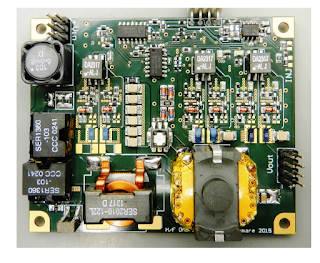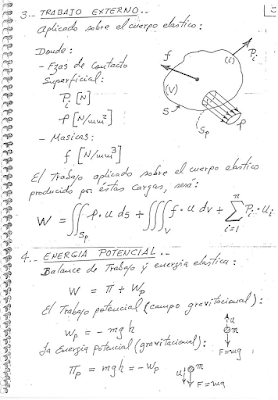segunda-feira, 29 de abril de 2019
Analysis of the Structures of Switching Power Supplies in the Environment OrCAD/PSpice By David Krajc-Technical University of Ostrava
Analysis of the Structures of Switching Power Supplies in the Environment OrCAD/PSpice By David Krajc Technical University of Ostrava
Abstract The thesis deals with switching power supplies and theirs characteristics. At the beginning of this thesis is a division of switching power supplies, describes the principles function and the basic characteristics circuits. They are then made suggestions of circuit components for Forward, Flyback and Push-Pull switching power supply. On the basis of simulation models are made in the environment OrCAD / PSpice subject for Power Semiconductor Systems II. At the end of the thesis simulated results are comparing with theoretical assumptions.
LINK ORIGINAL
https://core.ac.uk/reader/84391389
CONVERTISSEURS DC/DC A BASE DE HFETs GaN POUR APPLICATIONS SPATIALES Présentée et soutenue par : M. GUILLAUME DELAMARE Ecole doctorale : Génie Electrique, Electronique, Télécommunications (GEET) DOCTORAT DE L'UNIVERSITÉ DE TOULOUSE
Abstract Improving the compactness and efficiency of switching converters is a central issue in power electronics ; even more so in satellites where every gram and every watt counts. Each of the many radio-frequency emitters and receivers onboard telecommunications satellites need to be powered by various voltages, converted in an isolated way from the main power distribution bus. Due to the strong thermal, reliability and radiation hardness constraints applying to electronic components in space applications, available degrees of freedom for improvement of power supplies are limited - at least with current qualified semiconductor technologies (which are both expensive and far behind state-of-the-art performance). The recent commercialization of gallium nitride (GaN) normally-off power transistors, having superior electrical characteristics compared to the best silicon power MOSFET, is promising on that regard. Indeed, their intrinsic radiation hardness seems to allow their use in space-grade converters. The aim of this work is the evaluation of how this technology can help improve the design of isolated DC/DC power supplies for typical hardware units of telecommunications satellite payloads. Operation at higher switching frequencies with these better performing components should, in principle, reduce converters’ footprint while keeping the same (or better) efficiency level and still obeying each application’s specific requirements. The accuracy of this hypothesis as well as the most adequate implementation architecture have been explored for the low power supply of a RF receiver, including realization and comparison of several demonstration boards. In order to approach higher power converters, a theoretical and experiment study of switching losses in GaN transistor bridge legs has been performed. A performance computation software has been developed in Python and used to identify the global optimum of the design of a Dual Active Bridge converter for a power RF amplifier (250W DC). A prototype board has been built and demonstrated the interest of both the topology and GaN devices in this application, while clearly showing that high-frequency losses in magnetic components dominate total converter loss. This last issue happens to be the main limitation of the approach - precious to the engineer - of optimum design by computation : currently existing models for power loss estimation in magnetic elements are not satisfactory to predict performances of this type of converter.
LINK ORIGINAL
https://core.ac.uk/download/pdf/78385176.pdf
sábado, 27 de abril de 2019
Couplage des systèmes photovoltaïques et des véhicules électriques au réseau Problèmes et solutions -Van Linh Nguyen- Energie électrique.Université de Grenoble-Thése
Couplage des systèmes photovoltaïques et des véhicules électriques au réseau Problèmes et solutions Van Linh Nguyen -Energie électrique-Université de Grenoble
LINK ORIGINAL
https://hal.archives-ouvertes.fr/tel-01115864/document
sexta-feira, 19 de abril de 2019
SiC MOSFET 게이트 구동 방식 연구 = A Study on the SiC MOSFET Gate Drive Method-Author Ki-hyun Kim-2019-Department of Electrical and Computer Engineering The Graduate School Pusan National University
A Study on the SiC MOSFET Gate Drive Method Ki-hyun Kim
Department of Electrical and Computer Engineering The Graduate School Pusan National University
Abstract
In this thesis, power MOSFET gate drive IC with novel soft-switching gate drive method and short-circuit protection method is designed and implemented. Designed IC is suitable for driving silicon carbide (SiC) power MOSFET. The proposed gate drive IC, which employs the high side and low side soft-switching controller, can reduce the overshoot and switching loss of the SiC power MOSFET during the turn-on period effectively. The short-circuit protection circuit which is adopted the proposed gate drive IC uses de-saturation detect circuit for detecting the short-circuit condition of the switching device and safely cuts off the short-circuit transient current by using the clamp circuit and the multi-sync drive circuit. The multi-sync drive circuit, which is composed of two n-MOSFET and one soft turn-off controller, adjust the sink current for switch cut-off by 3 steps. In this thesis, simulation and experiment were performed to verify the electrical characteristics of the gate drive IC for the SiC power MOSFETs with the two proposed techniques. The proposed short-circuit protection circuit detects the short-circuit condition within 800 ㎱ and safely cuts off the switching device from the short-circuit condition within 1.4 ㎲ after short-circuit condition detected. With the use of the proposed gate drive IC, switching loss of the SiC power MOSFET decreased by 14 % without sacrificing the overshoot characteristics.
LINK ORIGINAL: http://www.riss.kr/search/detail/DetailView.do?p_mat_type=be54d9b8bc7cdb09&control_no=d1e7f72eff713d63ffe0bdc3ef48d419
LINKALTERNATIVO: https://www.mediafire.com/file/7lvmf7wemwvy57a/silicon_carbide_driver.pdf/file
domingo, 14 de abril de 2019
sexta-feira, 12 de abril de 2019
2019 ON SEMICONDUCTOR POWER SEMINAR SAO PAULO BRAZIL APRIL 30
2019 ON SEMICONDUCTOR POWER SEMINAR SAO PAULO BRAZIL APRIL 30
LINK ORIGINAL REGISTER
https://www.onsemi.com/PowerSolutions/content.do?id=19281&utm_source=hpb&utm_medium=home_page_banner&utm_campaign=AMR_Power_Seminar2019&utm_content=link-landing-page
LINK ORIGINAL REGISTER
https://www.onsemi.com/PowerSolutions/content.do?id=19281&utm_source=hpb&utm_medium=home_page_banner&utm_campaign=AMR_Power_Seminar2019&utm_content=link-landing-page
domingo, 7 de abril de 2019
Converter Using Voltage Doubler Hee-Jun Lee*, Soo-Cheol Shin**, Seok-Jin Hong*, Seung-Wook Hyun*, Jung-Hyo Lee*** and Chung-Yuen Won
Performance Improvement of Isolated High Voltage Full Bridge Converter Using Voltage Doubler Hee-Jun Lee*, Soo-Cheol Shin**, Seok-Jin Hong*, Seung-Wook Hyun*, Jung-Hyo Lee*** and Chung-Yuen Won
Abstract – The performance of an isolated high voltage full bridge converter is improved using a voltage doubler. In a conventional high voltage full bridge converter, the diode of the transformer secondary voltage undergoes a voltage spike due to the leakage inductance of the transformer and the resonance occurring with the parasitic capacitance of the diode. In addition, in the phase shift control, conduction loss largely increases from the freewheeling mode because of the circulating current. The efficiency of the converter is thus reduced. However, in the proposed converter, the high voltage dual converter consists of a voltage doubler because the circulating current of the converter is reduced to increase efficiency. On the other hand, in the proposed converter, an input current is distributed when using parallel input / serial output and the output voltage can be doubled. However, the voltages in the 2 serial DC links might be unbalanced due to line impedance, passive and active components impedance, and sensor error. Considering these problems, DC injection is performed due to the complementary operations of half bridge inverters as well as the disadvantage of the unbalance in the DC link. Therefore, the serial output of the converter needs to control the balance of the algorithm. In this paper, the performance of the conventional converter is improved and a balance control algorithm is proposed for the proposed converter. Also, the system of the 1.5[kW] PCS is verified through an experiment examining the operation and stability.
LINK
http://www.kpubs.org/article/articleDownload.kpubs?downType=pdf&articleANo=E1EEFQ_2014_v9n6_2224
sábado, 6 de abril de 2019
Kienitz, Karl Heinz Análise de circuitos: um enfoque de sistemas / Karl Heinz Kienitz – 2.ed. – São José dos Campos: Instituto Tecnológico de Aeronáutica, 2010.
http://www.ele.ita.br/~kienitz/
LINK DIRECTO PARA BAIXAR O LIVRO
http://www.ele.ita.br/~kienitz/circuitos/ISBN-978-85-87978-17-2.pdf
quinta-feira, 4 de abril de 2019
Assinar:
Postagens (Atom)



















































































 JOSIL ARTISTA PLASTICO FORTALEZA CEARA BRASIL AV.HERACLITO GRAÇA 41 TEL(85)32542378
JOSIL ARTISTA PLASTICO FORTALEZA CEARA BRASIL AV.HERACLITO GRAÇA 41 TEL(85)32542378















